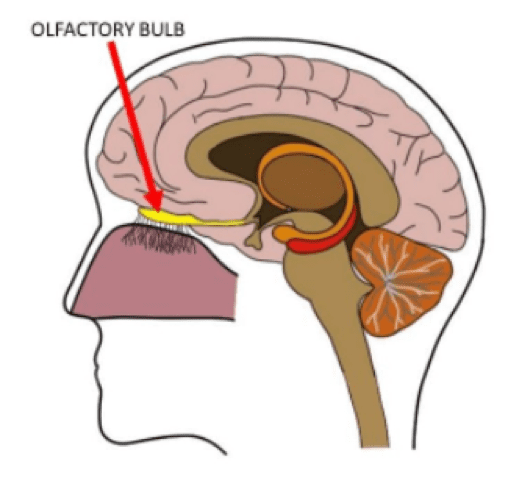Lately, our noses have been getting a lot more attention. COVID-19 changed the way our noses interact with the outside world, from covering them up with a mask to experiencing diminished sense of smell as a symptom of the virus (as noted by the association between viral outbreaks and poor reviews for scented candles)1. Of the over 500 million people that have now contracted COVID worldwide2, about 38% develop anosmia, or loss of sense of smell3. Amid the booming interest in the role of olfaction in our physical health, an often-overlooked phenomenon is the relationship between our sense of smell and mental health.
Olfactory dysfunction has long been linked to depression. In one study, patients with depression exhibited reduced olfactory function compared to non-depressed controls, and symptoms of depression worsened with the severity of olfactory impairment4. Reduced olfactory function in patients with depression can be recovered by treatment with antidepressants5. Experts believe the relationship between depression and olfaction is bi-directional, meaning depression may pre-dispose an individual to olfactory dysfunction, or olfactory dysfunction may predispose an individual to depression. To further disentangle this relationship, some researchers have investigated how changes in the brain area responsible for olfaction impacts symptoms of depression.
The olfactory bulb (OB), a brain area responsible for processing odor information, is impacted by depression. Studies show that patients with depression have smaller OBs than non-depressed individuals6. Lesioning, or surgically removing, the OB in rodents induces several behavioral changes that mirror symptoms of human depression. These include hyperactivity, deficits in memory, and changes in food-motivated behavior, all of which can be reversed by treatment with antidepressants7. In fact, the OB lesion rodent is the only animal that accurately models the long-term human response to antidepressant drugs8.
The olfactory system is the only sensory system that relays information directly from the sensory organ (i.e. nose) to the brain (i.e. OB)9. For other sensory organs (such as ears, mouth and skin), information is first condensed and sent through a structure called the thalamus, which acts as a middleman, before making its way to the sensory cortex. The olfactory system’s unique access to the brain means that a particular smell can directly initiate a cortical response.

In particular, the importance of the OB in depression relates to its connection with brain areas involved in emotion and memory, particularly the amygdala and hippocampus11. The amygdala is involved in processing threatening stimuli12, while the hippocampus has a major role in learning and memory and is affected by many psychiatric disorders13. Patients with depression exhibit increased resting-state activity in the amygdala as well as exaggerated reactivity in response to negative emotional stimuli14. Additionally, prolonged depression is linked to cell death and loss of volume in the hippocampus.
Why would the olfactory system be so integrated with brain areas crucial for emotional regulation and memory processes? The answer likely lies in adaptive evolution, as odors provide critical information for survival, influencing everything from our social relationships to our food intake15-17. Today, dysfunction in the OB-amygdala-hippocampus circuit underlies many of the behavioral, immunological, and neurochemical changes associated with depression.

Changes in emotion and memory processing in response to olfactory dysfunction present important implications for COVID-19 patients who lose their sense of smell either temporarily or permanently due to the virus18. Over half of a sample of COVID survivors in the United States reported symptoms of depression months after recovery, with those who experienced more severe symptoms of the virus exhibiting increased depression19. There are many potential factors that contribute to this trend, including changes in energy level and behavior resulting from the body’s immune response and the psychological stress of contracting COVID20,21. However, a recent study found that only the severity of smell and taste loss during COVID infection, and not more life-threatening symptoms such as shortness of breath or fever, correlated with depressed mood22. While further studies will need to be conducted to explain this finding, the relationship between the intensity of olfactory impairment and depression suggests that the OB circuit may be playing a role. With so many people facing the aftermath of COVID-19 illness, paying attention to the impact olfaction has on mental health will become more important than ever.
References:
- Analysis | What negative candle reviews might say about the coronavirus. Washington Post.
- Weekly epidemiological update on COVID-19 – 1 June 2022. https://www.who.int/publications/m/item/weekly-epidemiological-update-on-covid-19—1-june-2022.
- Mutiawati, E. et al. Anosmia and dysgeusia in SARS-CoV-2 infection: incidence and effects on COVID-19 severity and mortality, and the possible pathobiology mechanisms – a systematic review and meta-analysis. F1000Research 10, 40 (2021).
- Kohli, P., Soler, Z. M., Nguyen, S. A., Muus, J. S. & Schlosser, R. J. The Association Between Olfaction and Depression: A Systematic Review. Chem. Senses 41, 479–486 (2016).
- Croy, I., Symmank, A., Schellong, J., Hummel, C., Gerber, J., Joraschky, P., & Hummel, T. (2014). Olfaction as a marker for depression in humans. Journal of Affective Disorders, 160, 80–86. https://doi.org/10.1016/j.jad.2013.12.026
- Rottstaedt, F. et al. Size matters – The olfactory bulb as a marker for depression. J. Affect. Disord. 229, 193–198 (2018).
- Kelly, J. P., Wrynn, A. S. & Leonard, B. E. The olfactory bulbectomized rat as a model of depression: An update. Pharmacol. Ther. 74, 299–316 (1997).
- Morales-Medina, J. C., Iannitti, T., Freeman, A. & Caldwell, H. K. The olfactory bulbectomized rat as a model of depression: The hippocampal pathway. Behav. Brain Res. 317, 562–575 (2017).
- Purves, D. et al. The Organization of the Olfactory System. Neurosci. 2nd Ed. (2001).
- @neurochallenged. Know Your Brain: Olfactory Bulb. @neurochallenged https://neuroscientificallychallenged.com/posts/know-your-brain-olfactory-bulb.
- Rochet, M., El-Hage, W., Richa, S., Kazour, F. & Atanasova, B. Depression, Olfaction, and Quality of Life: A Mutual Relationship. Brain Sci. 8, 80 (2018).
- Baxter, M. G. & Croxson, P. L. Facing the role of the amygdala in emotional information processing. Proc. Natl. Acad. Sci. 109, 21180–21181 (2012).
- Anand, K. S. & Dhikav, V. Hippocampus in health and disease: An overview. Ann. Indian Acad. Neurol. 15, 239–246 (2012).
- Ramasubbu, R. et al. Reduced Intrinsic Connectivity of Amygdala in Adults with Major Depressive Disorder. Front. Psychiatry 5, (2014).
- Athanassi, A., Dorado Doncel, R., Bath, K. G. & Mandairon, N. Relationship between depression and olfactory sensory function: a review. Chem. Senses 46, bjab044 (2021).
- Brand, G. & Schaal, B. L’olfaction dans les troubles dépressifs : intérêts et perspectives. L’Encéphale 43, 176–182 (2017).
- Croy, I. & Hummel, T. Olfaction as a marker for depression. J. Neurol. 264, 631–638 (2017).
- Agyeman, A. A., Chin, K. L., Landersdorfer, C. B., Liew, D. & Ofori-Asenso, R. Smell and Taste Dysfunction in Patients With COVID-19: A Systematic Review and Meta-analysis. Mayo Clin. Proc. 95, 1621–1631 (2020).
- WebMD. The Link Between COVID-19 and Depression. WebMD https://www.webmd.com/lung/covid-19-depression (2022).
- Larson, S. J. & Dunn, A. J. Behavioral Effects of Cytokines. Brain. Behav. Immun. 15, 371–387 (2001).
- Wright, C. E., Strike, P. C., Brydon, L. & Steptoe, A. Acute inflammation and negative mood: Mediation by cytokine activation. Brain. Behav. Immun. 19, 345–350 (2005).
- Speth, M. M. et al. Mood, anxiety and olfactory dysfunction in COVID‐19: evidence of central nervous system involvement? The Laryngoscope 10.1002/lary.28964 (2020) doi:10.1002/lary.28964.
The post What your nose can tell you about mental health appeared first on Illinois Science Council.








Leave a Comment